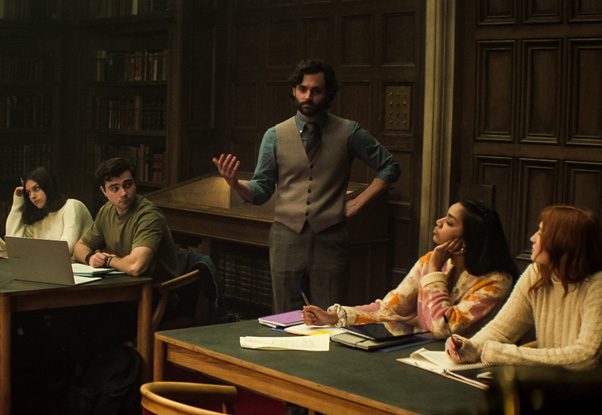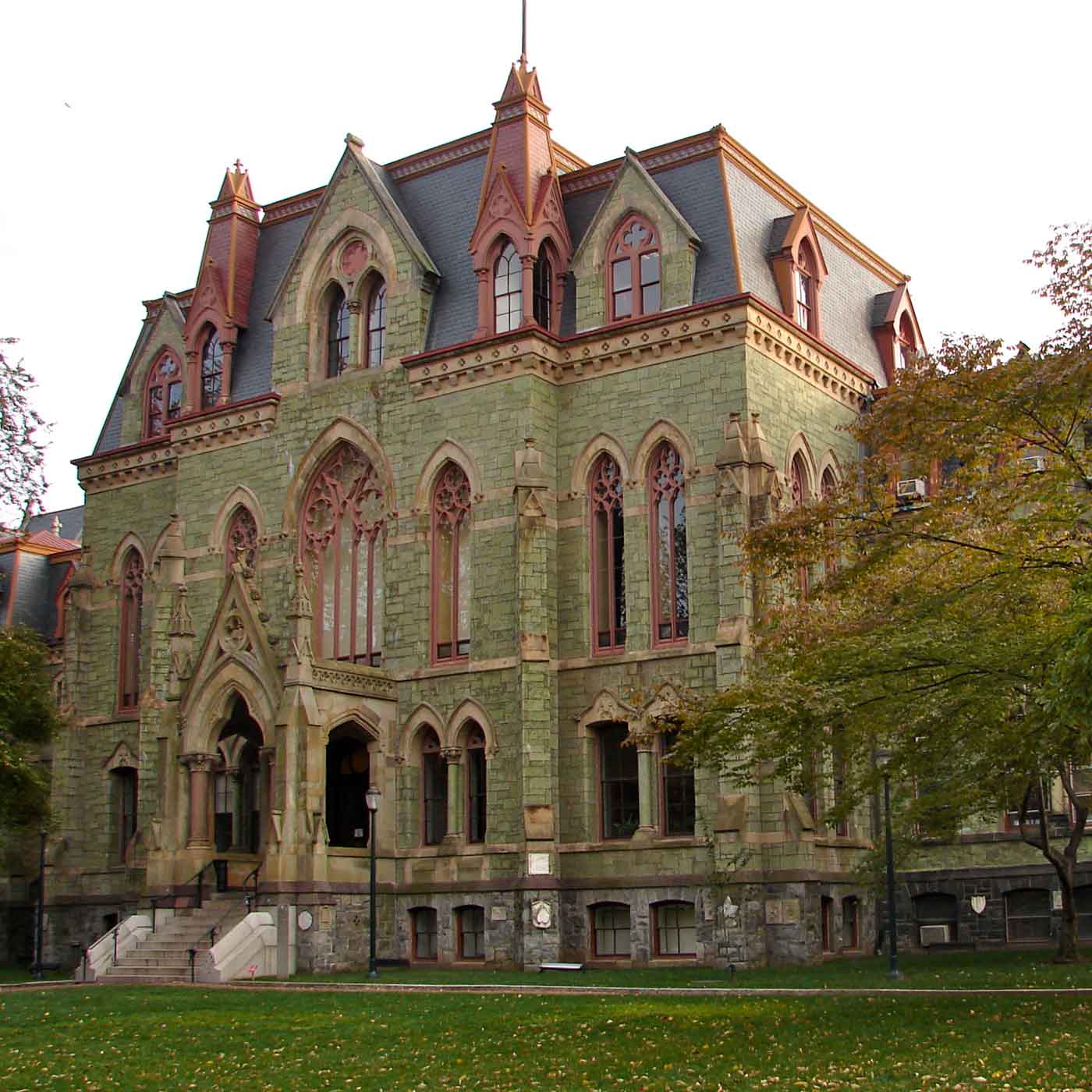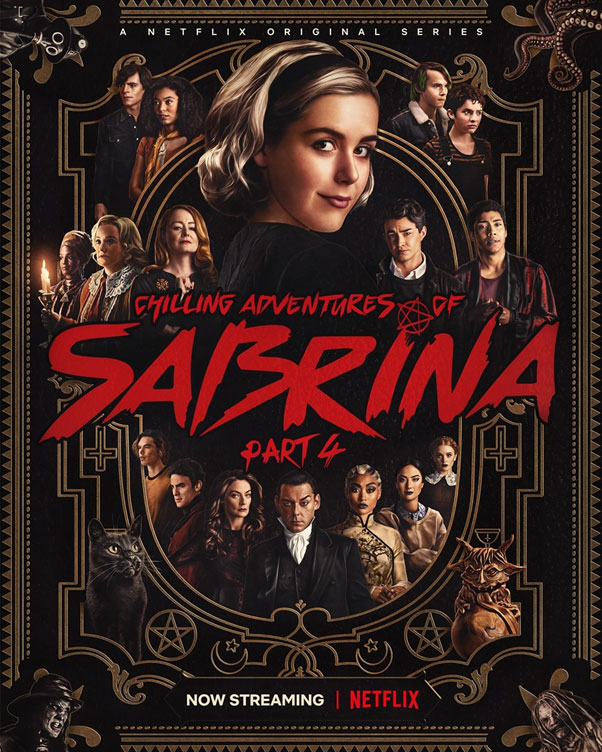Snobbery, longing and gothic edifices – the aesthetic of dark academia
Share this article

Can a night spent studying hard before an exam be a romantic experience? Perhaps those who feel relieved to have completed their formal education might find it difficult to believe such an idea. And yet – the dark academia aesthetic, one of the most influential online visual trends of recent years, suggests that there is nothing more beautiful than time spent perusing dusty books from a university library.

The term ‘dark academia’, according to the entry on KnowYourMeme, was coined as early as 2017, but it wasn’t until the coronavirus pandemic – which, by the way, seemed to foster interest in many micro-aesthetics and 80s nostalgia – that it really became popular. What is the essence of this trend? Dark academia is the dream of studying at a prestigious Anglo-Saxon university – but not so much a contemporary one, but rather one from a few decades ago. The axis of this dream academic experience, then, is not laboratory classes with state-of-the-art equipment and setting up a start-up after classes but endless discussions with eccentric lecturers, solitary studies of poetry from long ago, gallons of coffee and chain smoking. All this accompanied by the dusky halls of gothic edifices and the immaculate style of tweed jackets.
However, the above description does not clarify an important issue: how do we embody the aesthetics of dark academia? This is the problem with all micro-aesthetics – they can just as easily be treated solely as some internet phenomenon expressed in stylised photos on Instagram as a fully-fledged lifestyle idea. It’s no different with the dark academia aesthetic; one can consider it an ephemeral term used primarily to capture traditionalist tendencies in contemporary fashion, or one can look at it more broadly – as a certain lifestyle or even a subculture. So let’s take a look at what it actually is and from what this phenomenon with rather blurred boundaries emerges.
Perhaps nothing ensures micro-aesthetics so much popularity as the opportunity to apply them in the field of clothing. This is not surprising; regardless of what we think about it, fashion is the most obvious way of expressing one’s status, lifestyle or beliefs. Even opting out of participating in such a form of self-expression – if only in the spirit of the once high-profile normcore – also sends a certain message. This is why dark academia has gained popularity – on Instagram, TikTok and Pinterest – primarily as a fashion trend.

The main inspiration for the dark academia aesthetic is the academic elegance of more or less the 1930s, 1940s and 1950s. It’s generally quite conservative, although not evening fashion – it’s more of a retro smart casual. The colour palette of the style is subdued: shades of grey, brown, beige and, of course, black prevail. High-quality, natural materials – such as tweed or, in the case of shoes and accessories, leather – and classic patterns, especially checks, are favoured. Wardrobes of dark academia fans include oversize jackets and trousers, warm jumpers and turtlenecks, maxi skirts (although there is no shortage of styles with much less conservative mini skirts), coats and leather boots – in short: everything we would expect to see on Western university campuses decades ago, only in a modernised version.
Dark academia, as a fashion trend, is notably retromania in spirit – and in line with how Simon Reynolds described retromania, it is not interested in faithfully recreating the past. It is more of a free remix of fashion inspirations from years ago, filtered through contemporary aesthetic sensibilities – more a reference to the broad idea of 20th century ‘classicism’ than a reconstruction of the fashion of a particular decade. On a side note: it is rather amusing that an academic community – associated with intellectual life rather than a focus on one’s own appearance – has become a certain benchmark of elegance in this trend.

Participation in the dark academia subculture – if this word is warranted here – is not limited to following a specific set of fashion tips. Like other online micro-aesthetics, dark academia offers much more – including suggestions for preferred activities, hobbies, and lifestyles. The focus of the trend is – at least declaratively – on reading and expanding one’s horizons, especially in the fields of classical literature, history, foreign languages, mythology, art and philosophy. The educational ideal of dark academia is therefore not contemporary humanities, with cultural studies, deconstruction or reflection on pop culture. Closer to it is the study of the past in its broadest sense, which appears as a lost and, at the same time, more noble world.
Nights spent studying, writing essays for hours on end, perusing books while being carried along by successive footnotes – although for many this sounds like an unattractive memory, dark academia sees these activities as the true joy of university life. In addition, and somewhat paradoxically: a joy that usually comes from reflecting on what is irretrievably lost, pessimistic and melancholic. Dark academia, true to its name, gravitates to some extent towards the gothic subculture.

Dark academia’s aesthetic requirements for other spheres of life are also, perhaps unsurprisingly, quite a traditionalist. The interiors should be filled with massive wooden bookcases capable of holding an extensive collection of books (preferably rare, first editions in leather bindings); tasteful decorations include old engravings and maps, marble busts and banker’s lamps. If there’s music, it’s classical or jazz – and vinyl is a must. Leaving home? To a bookshop (even better: an antique shop), a library or a stylish, quiet café, where you can – of course – read while enjoying a cup of black coffee.
The full achievement of a lifestyle in the spirit of dark academia requires the right economic background. While stylish clothes can be sourced second-hand and books can be borrowed from libraries – what is much more difficult is that the in-depth study of fields of knowledge that are fascinating but not very practical in today’s job market is an investment of time that few can afford. Studying for many hours every night – what’s more: motivated by a keen interest, not just the need to master the bare minimum of material – is difficult to combine with a student job. Spending time in cafés is certainly facilitated by relative economic stability. So, does dark academia offer a vision of life accessible to a relatively privileged few? Let’s take a closer look at the critique of this trend.

One of the more common criticisms of dark academia is that of its superficiality and pretentiousness – that it is more a fetishisation of intellectual life than real intellectual life; not a reading society, but a Dead Poets Society cosplay. The French sociologist Jean Baudrillard promoted the notion of the ‘precession of simulacra’; a process by which various signs move further and further away from their source – to the point where they ultimately represent nothing but themselves. Dark academia can be interpreted as an example of this process in action. Since real academic life has less and less to do with a romantic yet intellectual adventure and more and more to do with business and investment, the least we can do is to bring to life an aesthetic that reminds us of the fading ethos – that is, dark academia.
The issue of money – mentioned above – is also not without significance. Dark academia, as a trend that has emerged on the internet, is gaining popularity all over the world – and therefore both in places where higher education is strictly financially driven and in places where it is, at least in theory, free. ‘In theory’, because entering a free university also requires competing with other classmates – adequate cultural capital is necessary, and often also money for moving out or everyday expenses. Dark academia proposes a very idealised vision of the academic lifestyle – one in which the money is simply there, and therefore one can focus solely on learning. Against the backdrop of increasingly strong cultural currents and aesthetics that condone imperfection, a certain chaotic nature of life and even failure, dark academia appears as an eminently conservative phenomenon – from a not so distant time when we (perhaps) believed that we absolutely had to exude a strictly designed image on social media.
Speaking of idealisation, another criticism of dark academia is that it encourages unhealthy behaviour, both physically (caffeine-fuelled all-night study sessions) and mentally (the pressure to be the best and the need for constant competition). The pursuit of perfection comes at a price.

At the intersection of the criticism related to the superficiality of dark academia and that related to class aspects, another problematic area emerges – related to prestige and snobbishness. Dark academia does not fetishise every form of higher education, but only one that has been undertaken at a suitably prestigious institution, with a long tradition and an awe-inspiring seat. The academic obsession with tradition (and its reflection in aesthetics) is not a new phenomenon – one need only think of the mania for building neo-Gothic edifices that swept across American universities at the turn of the 20th century. These were intended to indicate continuity between the academic identity emerging in the United States and the much older, medieval traditions of Oxford and Cambridge. With some caution, it can be assumed that dark academia is part of a long history – if not of intellectual continuity, then certainly of snobbish, Eurocentric obsession.

The internet loves niches – so much so that each niche sooner or later has to break down into a series of even smaller, more specific trends. Dark academia has spawned a whole family of ‘academic’ aesthetics – there are so many that Aesthetic Wiki has dedicated a separate category to them. Some, such as darkest academia and occult academia, place an even greater emphasis on gothic inspiration – thus becoming a fantasy not so much of studying at any of the Ivy League universities, but rather at Hogwarts or the Academy of Unseen Arts from the Chilling Adventures of Sabrina series and comics. Other ‘academies’ – do the opposite; they attempt to cast off the burden of gloom and pop nihilism and instead focus on what is joyful, optimistic and friendly about academic life (and the attitude that accompanies it).

Light academia is precisely such an optimistic proposal. In practical terms, it is not an aesthetic negation of dark academia – rather, it is a shift in emphasis. Light academia still appreciates everything that is classic or retro, whether in dress or the way we spend our time – but the point is that all this weight of tradition should not be used as a pretext for sinking into melancholy, misanthropy or an exaggerated resentment towards the world. Of course, this change is most evident in the fashion proposals, which are slightly more casual and in a lighter colour palette. However, it is also an idea for a different lifestyle. While dark academia tempts us with the allure of reading tragic tales alone at night, light academia encourages witty discussions with friends during a morning picnic in the park.

Other ‘academies’ go even further in modifying the original idea. Some focus on specific areas of interest – hence the nature-focused (and somewhat goblincore) aesthetics of green academia, hence the creativity-focused aesthetics of art academia and writer academia. Some, on the other hand, attempt to at least partially reject the conservative corset – such as the internet academia trend, which represents an aestheticisation of, often pandemic-enforced, online learning. It is likely that we will see the emergence of more similar ideas – micro-aesthetics are, after all, strengthened by division.
Dark academia and related aesthetics are a fantasy of the academic experience in a form that is becoming less and less accessible. Perhaps the main factor that made it possible was the coronavirus pandemic mentioned earlier – many people lost the chance to start their secondary or tertiary education in the classic, classroom-based way and so were forced to spend hours in front of a computer. Instead of walks in university corridors – Zoom or Microsoft Teams. Instead of lively discussions with new friends – a chat room dedicated to the pragmatic aspects of a shared course. The main fuel for romanticisation is absence – dark academia can therefore be interpreted as a reaction to a sudden change in conditions, moreover: a radical reaction, because it reaches back to patterns so out of date that they were difficult to follow even before the pandemic.
The word ‘crisis’ accompanies many aspects of life – including the university. The challenges of universities vary from one place to another; however, they are united by the issue of the role of the university in the modern world. Who and what do universities actually serve? Doesn’t the modern world require more flexible forms of education? Is it all still about the celebration of knowledge or is it just business? The crisis of the university is even more acute in the humanities, which, for better or worse, are trying to find their place in an increasingly technology-dominated world. Dark academia is a certain – superficial, but symptomatic – response to these doubts and problems: it is an attempt to revive a world that no longer actually exists, even if some people still study in the respectable edifices of centuries-old institutions.
So, why this longing for the ‘old university’ – felt by those who have never had the chance to experience it? Perhaps part of the answer lies in popular culture, which is a powerful archive, but also a source of social perceptions or expectations. The school environment, less often the academic environment, is the setting of countless coming-of-age films that project what an educational experience should look like (emotionally and socially). Even the Harry Potter series, one of the greatest pop culture phenomena of recent decades, is essentially a story about school as a vehicle for a sense of community and a certain ethos. Dark academia is also a reaction to the reality that technical knowledge is becoming obsolete more and more quickly – hence the obsession with ‘classical’ knowledge concerning the deep sources of culture. So, while criticism of dark academia in many cases is very justified, we can look at it favourably – as an attempt to find our way in an increasingly complex world.

Found this article interesting? We encourage you to check out other articles from the intersection of culture and art: